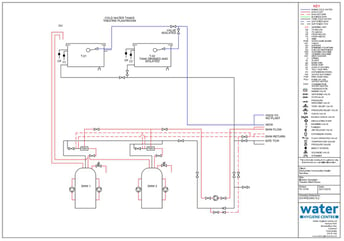
Records are a foundation stone of successful water hygiene management. They are evidence, without which, it is very difficult to convince others that a task has been completed.
Water Hygiene Guidance & Legislation
Under the Health and Safety at Work etc Act, COSHH and Management of Health and Safety at Work Regulations, where there are 5 or more employees, there is a requirement to record;
- The significant findings of the risk assessment;
- The steps taken to prevent exposure to substances hazardous to health;
- Examinations, tests and repairs of control measures.
This is echoed in the HSE’s ACoP L8, where guidance is given specifically for water safety and Legionella control.
What have we learnt?
Indeed, several of the failures found following the largest Legionnaires’ disease outbreak in the UK (Barrow-in-Furness 2002), related to a lack of water hygiene records, including Legionella risk assessments, risk minimisation schemes, Legionella training records and a written management system.
What water hygiene records are required?
Before we look at what equates to “good” records, let’s just summarise the types of records an employer will require for water hygiene management.
- Water Hygiene / Legionella Risk Assessments – a documented assessment identifying and assessing the source of risk. This may include Legionella, Pseudomonas aeruginosa, other opportunistic pathogens or scalding;
- Water Safety Plan - “a strategic plan which defines and documents the arrangements that are required for the safe use and management of all water systems together with all associated systems and equipment, within each building or estate to prevent harm arising from all forms of exposure.” BS 8680. This will include a policy and a written scheme of control.

- Schematic drawings – “a simplified but accurate illustration of the layout of the water system” HSG 274 Part 2. You also may have as-fitted drawings of the water system.
- Legionella Training records – certificates of appropriate training from management to operations. This should also include competence records.
- Appointments – “The duty holder should specifically appoint a competent person or persons to take day-to-day responsibility for controlling any identified risk from legionella bacteria, known as the ‘responsible person’ ACoP L8. This could also extend to “Authorised” and “Competent” Persons.
- Water Hygiene Audits – Undertaken by your health and safety team or your Authorising Engineer (Water).
- Monitoring, inspection, and cleaning records – also known as Planned Preventative Maintenance records.
These records can be kept in a variety of places, from a humble physical “logbook” kept in a caretaker’s cupboard, to an elaborate piece of software. Wherever your records are kept, they must be easily accessible for all that need to inspect them.
What are 'good' records?
“Good” records must not only be those that simply exist and to satisfy regulation, but they must also have a purpose. So, in essence, “good” records should be;
- Accessible – Employees must be able to always access these records easily for instruction, or to simply update them. External auditors may also need to see records at a moments notice, so it is important that the relevant employees know where they are kept;
- In date – Records that are out of date may not reflect the water systems that are in place, therefore wrong information may lead to wrong actions;
- Signed - All records should be signed, verified, or authenticated by those people performing the various tasks assigned to them.
- Useful – if the information in the records is either not easily understood or is simply wrong, correct procedures are not followed, which lead to mistakes. A risk legionella assessment also needs to be easy to follow so that all risks are managed appropriately.
- Effective – Records such as procedures must lead to the correct action. Also, records of non-compliant checks and inspections must lead to follow up solutions and/or remediation.
- Reviewed – By regularly reviewing the documents listed above, records will remain accurate and valid.
- Auditable – Records such as monitoring, and inspection checks should be filed in an organised fashion. This makes auditing and analysis much easier, allowing trends and errors to be spotted.
- Informative – Records such as a Water Safety Plan must contain all the information that is needed to manage water safety at your organisation. If the answer to a question regarding the management of it is not in it, it should be.
Records such as Legionella risk assessments, Water Safety Plans and appointments should be retained throughout the period they are current and for at least two years afterwards. Records such as monitoring inspections, tests or checks should be kept for at least five years
In Summary
To summarise, to help achieve what could be regarded as “good” records, the required records…
- Need to exist in the first place;
- Should be relevant to the water systems and organisation;
- Should be in date;
- Should be accessible;
- Should be organised;
- Should prove the effectiveness of the control scheme;
- Should inform and allow changes to be made to the control scheme.
“Good” records prove we have a management system in place, they also, just as importantly, help keep water systems safe.
Feel free to reach out if you have any questions about this blog or if you would like to consult with one of our experts for further advice on water hygiene.
Editor’s Note: The information provided in this blog is correct at the date of original publication – February 2022.
© Water Hygiene Centre 2022








